Chess Notes
Edward Winter
When contacting us by e-mail, correspondents are asked to include their name and full postal address and, when providing information, to quote exact book and magazine sources. The word ‘chess’ needs to appear in the subject-line or in the message itself.
| First column | << previous | Archives [116] | next >> | Current column |
8578. ‘Perhaps the greatest sacrificial artist of all time’
From page 177 of The Art of Sacrifice in Chess by Rudolf Spielmann (London, 1935):
‘In the days of Anderssen, perhaps the greatest sacrificial artist of all time, a king-hunt sacrifice was no rarity.’
Spielmann’s original text is on page 77 of Richtig Opfern! (Leipzig, 1935):
‘In der Epoche von Anderssen, vielleicht des größten Opferkünstlers aller Zeiten, waren Jagdopfer keine Seltenheit.’
8579. Attributed to Spielmann
Further to the references to Rudolf Spielmann in Chess: the Need for Sources, the passage below comes from page 111 of The Bright Side of Chess by Irving Chernev (Philadelphia, 1948):
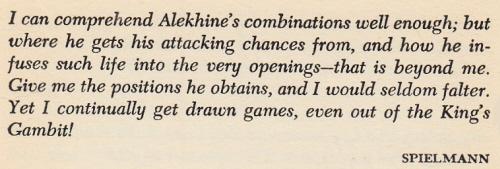
Can the original text be traced?
8580. Vidmar and Nimzowitsch
Another question arises from page 14 of Chernev’s The
Bright Side of Chess:
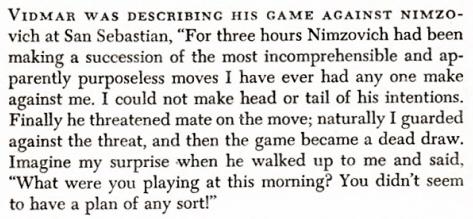
Where did Vidmar write those words, and was the reference really to his game against Nimzowitsch at San Sebastián, 1911 (as opposed to, perhaps, Carlsbad, 1911)?
8581. Tramp at Anchor
There are a few references to chess in Tramp at Anchor by Jim Phelan (London, 1954), e.g. on pages 66, 71, 110 and page 219. The last of these concerns his stretch in Parkhurst Prison:
‘I was careful. At that time I was near to the master class as a chessplayer, and I played my whole life as a chess game. Nothing was left to chance. Nothing was risked if it could be calculated. Survival – survival was my law and my life, for I knew that if ever again I was taken inside the walls I would die swiftly.’
The back of the dust-jacket:
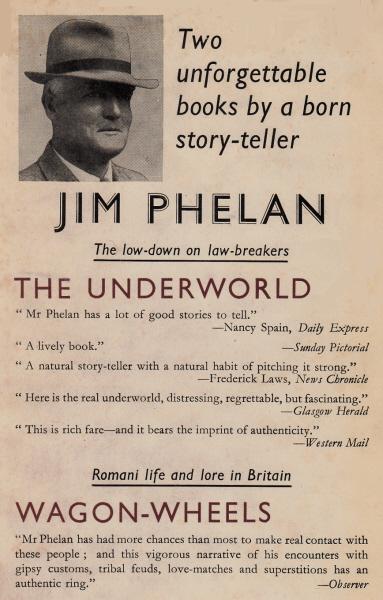
8582. Chess and machinery
‘Is this the beginning of the end for chess, or the end of the beginning?’
From page 38 of CHESS, November 1949:
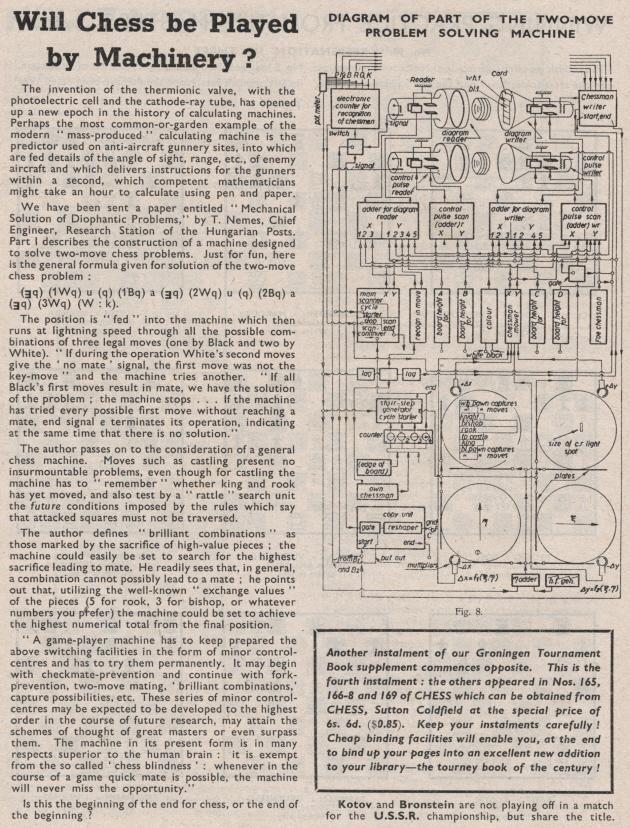
8583. Early Fairhurst games (C.N. 8569)
Michael McDowell (Westcliff-on-sea, England) sends a game from the Manchester Evening News, 25 November 1922:
Percy Francis Blake (Liverpool Chess Club) –
William Albert Fairhurst (Manchester Chess Club)
Liverpool, 11 November 1922
Ruy López
1 e4 e5 2 Nf3 Nc6 3 Bb5 a6 4 Ba4 Nf6 5 O-O Be7 6 Re1 b5 7 Bb3 d6 8 c3 Na5 9 Bc2 c5 10 d4 Qc7 11 Nbd2 Nc6 12 d5 Na5 13 Nf1 Bd7 14 Ne3 O-O 15 h3 Rfb8 16 Nh2 Rb7 17 Nf5 Bxf5 18 exf5 Nc4 19 g4 Nb6 20 g5 Nfxd5
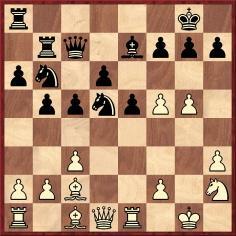
21 Be4 Nxc3 22 bxc3 d5 23 Bxd5 Rd8 24 Bxf7+ Kxf7 25 Qh5+ Kg8 26 g6 hxg6 27 fxg6 Bf6 28 Ng4 Rd6 29 Ne3 Nd5 30 Nf5 Ne7 31 Nxe7+ Resigns.
Blake’s obituary on pages 258-259 of the May 1936 BCM recorded:
‘In the first decade of this century he was much interested in play, was champion of the Manchester club, and of Lancashire, but returned in later years to problem work.’
8584. Shipman v Kevitz
Marc Hébert (Charny, Canada) notes that page 4 of Chess Life, 5 March 1948 published a game between W. Shipman and A. Kevitz (a 52-move victory for White beginning 1 e4 Nc6 2 Nf3 e5 3 Bc4 Nf6 4 d3 Bc5) played, it was said, in the ‘Manhattan Chess Club Championship Finals, New York, 1948’. However, according to the crosstable on page 3 of the April 1948 Chess Review, Kevitz did not participate in the event.
8585. Kevitz v Fine
From page 37 of Chess Review, January 1947 (an article by I.A. Horowitz):
‘In a match game with Grob, Flohr resigned when he was a piece to the good. He mistakenly believed that he could not stop a mate in one. In a similar situation, Fine resigned to Kevitz when he could force an easy draw by perpetual check.’
No details were given.
As indicated in the Factfinder, Flohr v Grob has been discussed in C.N. several times. The other game, played in the Metropolitan League, is on pages 69-70 of the April 1932 American Chess Bulletin:
Alexander Kevitz (Manhattan Chess Club) – Reuben
Fine (Marshall Chess Club)
New York, 16 April 1932
Dutch Defence
1 c4 f5 2 d4 Nf6 3 g3 e6 4 Bg2 Bb4+ 5 Nc3 O-O 6 Nf3 Nc6 7 O-O Bxc3 8 bxc3 Ne4 9 Qd3 b6 10 Ba3 Re8 11 d5 Na5 12 Bb4 Nc5 13 Qd4 d6 14 dxe6 Nxe6 15 Qd2 Bb7 16 Bxa5 bxa5 17 Rab1 Be4 18 Rb5 c6 19 Rb2 Nc5 20 Nd4 Bxg2 21 Kxg2 Qd7 22 Rfb1 Qf7 23 Nxc6 Qxc4 24 Qxd6 Na4 25 Rb7 Qe4+ 26 Kg1 Nxc3 27 h3 f4 28 Qc7 Qg6 29 Ne5 Rxe5 30 Qxc3 Rae8 31 Qc4+ Kh8 32 Qxf4 Rxe2 33 Rb8 h6 34 Rxe8+ Rxe8 35 Rc1 Qe6 36 Kh2 Qxa2 37 Rc7 Kg8 38 Qd4 Resigns.

C.S. Howell wrote in the Bulletin:
‘A most entertaining game. I am informed that both players were hard pressed for time. As is usual in such cases, the more experienced player wins out. Fine, a truly promising young player, here overlooks 38...R-K4! If White captures the rook, 39...QxPch draws.
Pillsbury once gave me a very useful bit of advice regarding clock difficulties. It was to note the time on the score-sheet after I made each move; after the game to play it over and try to explain to myself why I took so long to make obvious moves or ones that my chess instinct should have indicated. It is good discipline and will help young players who get into trouble with the clock.’
8586. ‘The Little Capablanca’ (C.N.s 6365 & 7054)
A slightly earlier citation than the one in C.N. 6365 is added below, from an interview with Rudolf Spielmann on page 12 of the Chess World, 1 October 1932:
‘... we may humorously term Flohr as being “Little Alekhine” and Kashdan as the “Little Capablanca”. Their style of play resembles in many respects that of these great champions.’
8587. A nineteenth-century skirmish (C.N.s 8573 & 8577)
From pages 190-191 of the December 1941 Schweizerische Schachzeitung:

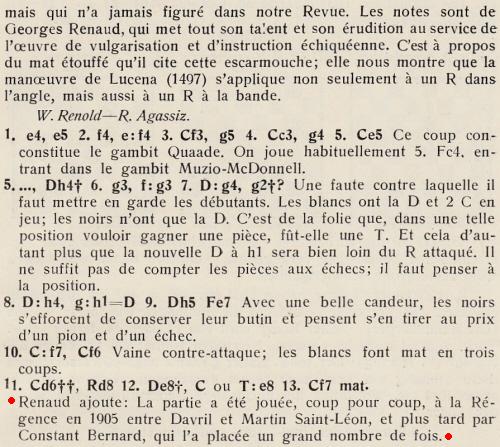
The game was also published on pages 44-46 of L’art de faire mat by G. Renaud and V. Kahn (Monaco, 1947). See too pages 39-40 of the English edition, The Art of the Checkmate (New York, 1953), which gave White’s initial as Q. rather than W. Both players’ forenames are available from the Schweizerische Schachzeitung in connection with chess in Lausanne: Wilhelm Renold (March 1903, page 87) and Rodolphe Agassiz (April 1903, page 93). The French and English editions of Renaud and Kahn’s book misspelled the opening of the game (‘Quade Gambit’).
There was material on the Quaade Gambit by W. Timbrell Pierce on pages 138-139 of the April 1913 BCM, with analytical comments from a correspondent, W.M. Hardman, on page 183 of the May 1913 issue and a reply from Pierce on page 236 of the June 1913 number. Shortly C.N. will be turning to the origins of the gambit, on the basis of nineteenth-century sources.
8588. Kevitz v Fine (C.N. 8585)

Position after 38 Qd4
From Lonnie Kwartler (Chester, NY, USA):
‘The defense suggested for Fine, 38...Re5, prolongs the game, but White still has a win with 39 Qd8+ Kh7 40 Qf6 Rg5 41 h4 Rg6 42 Qf5. (This position can be reached with 39 Rc8+ four moves later.) Of course, 38...Re5 would have been a good try, and if Black does not fall into mate White is “limited” to a clearly won endgame. Black cannot stop White’s attack without exchanging queens.’
8589. The Quaade Gambit (C.N.s 8573, 8577 & 8587)
Thomas Niessen (Aachen, Germany) writes:
‘Page 271 of the first (1984) edition of the Oxford Companion to Chess stated that the Quaade Gambit was “advocated by a Dutch sea-captain, D.L. Quaade, in 1884, but known earlier”. On page 328 of the second edition (1996) the entry was amended to read:
“... advocated by a Dutch sea-captain, D.L. Quaade, in 1882 but known earlier. The analysis was elaborated in the pages of Deutsche Schachzeitung by the German lawyer Carl Friedrich Schmid (1840-97).”
In the correspondence section of the November 1882 Deutsche Schachzeitung, page 360, there appeared the following:
“Oringe per Vordingborg, 3./10. (L.Q.). Sie schlagen im Königsgambit nach 1 e4 e5 2 f4 ef 3 Sf3 g5 den Zug 4 Sc3 vor. Derselbe wird sicherlich, und vielleicht nicht unvortheihaft, in Anwendung gebracht werden können, doch bedarf er einer gründlichen Untersuchung.” [“Oringe per Vordingborg, 3./10. (L.Q.). You suggest in the King’s Gambit, after 1 e4 e5 2 f4 exf4 3 Nf3 g5, the move 4 Nc3. This move can certainly be played, and is perhaps not disadvantageous, but it requires a thorough investigation.”]
The correspondent L.Q. from Oringe also appeared twice in the Deutsche Schachzeitung the following year. On page 64 of the February 1883 issue:
“Oringe, 20./12. (L. Q.). Prüfung der uns freundlichst mitgetheilten Varianten müssen wir uns vorbehalten.” [“We have not yet decided about an examination of the variations kindly provided to us.”]
And on page 223 of the July 1883 magazine:
“Oringe (Capt. L.Q.). Eine Ueberarbeitung Ihrer Vorschläge ist bereits von Herrn Dr. C. Schmid in Dresden vorgenommen worden. Sie müssen sich aber mit der Veröffentlichung noch so lange gedulden, bis wir Raum dafür gewinnen.” [“Dr C. Schmid of Dresden has already made a review of your proposals. You need to await publication until we have the necessary space.”]
Analysis appeared the following year. On page 167 of the June 1884 Deutsche Schachzeitung “L.Q.” was identified as L. Quaade:
His name was also given on pages 193 and 196 of the July 1884 Deutsche Schachzeitung and on page 228 of the August issue.
Since Oringe and Vordingborg are part of the Danish region Zealand (Sjælland), it is surprising that Quaade is called Dutch by the Oxford Companion to Chess and other sources. The earliest reference to “Dutch” that I have found is on page 510 of the seventh edition of Schallopp’s Handbuch des Schachspiels (Leipzig, 1891):
“Dieser Zug rührt von dem niederländischen Kapitän Quaade in Orinje [sic] her ...” [“This move is due to the Dutch Captain Quaade from Orinje [sic] ...”]
There are two genealogical sources online for a sea captain named Louis Magnus Johan Christian Carl Quaade, who was born in Helsingør on 7 March 1825 and died in Oringe/Vordingborg on 13 September 1906. See My Heritage and Geni.However, if this is the chessplayer L. Quaade, it means that page 203 of Johann Berger’s Schach-Jahrbuch für 1899/1900 (Leipzig, 1899) was mistaken in placing the symbol † against Quaade’s name, indicating that he was dead by 1899.’
Henk Smout (Leiden, the Netherlands), who has also mentioned the references to Quaade in the Deutsche Schachzeitung, points out with regard to the extract shown above that the Oxford Companion to Chess erred by putting ‘D.L. Quaade’. When the Deutsche Schachzeitung referred to ‘dem Kapitän a. D. L. Quaade’ it was using the German abbreviation ‘a. D.’, meaning außer Dienst (retired).
Concerning the references to Danish/Dutch, we wonder whether Oringe (Denmark) was simply confused with Orange (as in William of Orange).
8590. Steinitz games
Patsy A. D’Eramo (North East, MD, USA) has found the following games:
Wilhelm Steinitz – Jacob Elson
Philadelphia, 12 December 1882
French Defence
1 e4 e6 2 e5 d5 3 exd6 Bxd6 4 d4 Nf6 5 Nf3 h6 6 Bd3 Nc6 7 O-O O-O 8 Re1 Re8 9 c3 e5 10 dxe5 Nxe5 11 Nxe5 Bxe5
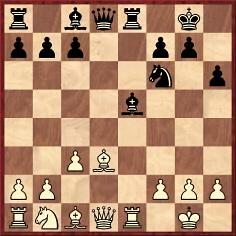
12 h3 Bd6 13 Rxe8+ Qxe8 14 Nd2 Qe5 15 Nf3 Qh5 16 Be3 Bd7 17 Nd4 Qe5 18 Nf3 Qh5 Drawn.
Source: Philadelphia Times, 13 December 1882, page 2.
Otho Michaelis – Wilhelm Steinitz
Fifth match-game, Philadelphia, 13 December 1882
Ruy López
1 e4 e5 2 Nf3 Nc6 3 Bb5 a6 4 Ba4 Nge7 5 d4 exd4 6 Nxd4 Nxd4 7 Qxd4 b5 8 Bb3 d6 9 c3 Be6 10 Bc2 Nc6 11 Qd1 Be7 12 O-O O-O 13 f4 Kh8 14 f5 Bd7 15 Bf4 Bg5 16 Nd2 Bxf4 17 Rxf4 Qg5 18 g3 Ne5 19 Qf1 Rae8 20 Nf3 Qf6 21 Re1 Re7 22 Qf2 c5 23 Nxe5 Rxe5 24 Qd2 Bc6 25 Rd1 Rd8 26 Qe3 Rde8 27 Qd2

27...d5 28 Qe3 dxe4 29 Rdf1 a5 30 R1f2 b4 Adjourned, with no result reported.
Source: Philadelphia Times, 14 December 1882, page 3.
Wilhelm Steinitz – M.J. Fass and James Wibray
New Orleans, 29 December 1882
(Remove White’s queen’s knight.)
1 e4 e5 2 Bc4 f5 3 d3 Nf6 4 Nf3 c6 5 O-O fxe4 6 dxe4 d5 7 exd5 e4 8 Ne5 cxd5 9 Bb5+ Bd7 10 Nxd7 Nbxd7 11 Bg5 Kf7 12 Kh1 Be7 13 f3 Ne5 14 fxe4 dxe4 15 Qh5+ g6 16 Qh4 Qd6
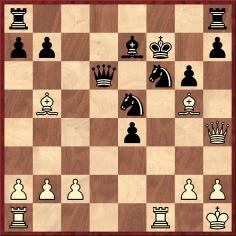
17 Bxf6 Bxf6 18 Rxf6+ Qxf6 19 Rf1 Qxf1+ 20 Bxf1 Rae8 21 Qxe4 Re7 22 Qd5+ Kg7 23 Qc5 Nc6 24 h3 Rc8 25 Qc3+ Kf7 26 b4 Rcc7 27 Qh8 Ke6 28 Bc4+ Kd7 29 Bb3 a6 30 a4 Nd8 31 b5 axb5 32 axb5 Re1+ 33 Kh2 Kc8 34 b6 Rce7 35 Qc3+ Nc6 36 Bd5 Kb8 37 Qh8+ Re8 38 Qxh7 Ne7 39 Bf3 Nc6 40 Qc7+ Ka8 41 Bxc6 Resigns.
Source: New Orleans Times-Picayune, 2 January 1883, page 8.
Wilhelm Steinitz – Otto M. Tennison
Simultaneous exhibition, New Orleans, 2 January 1883
King’s Gambit Accepted
1 e4 e5 2 f4 exf4 3 Nf3 g5 4 Bc4 Bg7 5 O-O h6 6 d4 d6 7 g3 g4 8 Ne1 f3 9 c3 Nf6 10 Bd3 Qe7 11 Na3 Bd7 12 Nc4 Nc6 13 b4 b5 14 Nd2 Nh7 15 Nb3 Ng5 16 Nc2 Nh3+ 17 Kh1 a6 18 Ne3 O-O-O 19 a4 Na7 20 axb5 Nxb5 21 Nd5 Qe6 22 Rxa6 c6 23 Bxb5 cxd5
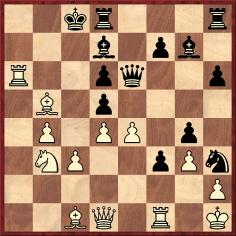
24 Nc5 Qe8 25 Qa4 dxc5 26 Ra8+ Kc7 27 Qa7+ Kd6 28 Qxc5+ Ke6 29 Ra6+ Bc6 30 Bxc6 Resigns.
Source: New Orleans Times-Picayune, 4 January 1883, page 3.
Wilhelm Steinitz – James Wibray
Simultaneous exhibition, New Orleans, 2
January 1883
Bishop’s Opening
1 e4 e5 2 Bc4 Nf6 3 f4 d6 4 Qe2 Bg4 5 Nf3 c6 6 d3 Nbd7 7 O-O Be7 8 Nc3 Qc7 9 Bb3 O-O-O 10 Bxf7 Rdf8 11 Bb3 Nh5 12 f5 Bh4
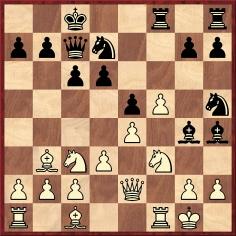
13 Qe3 Bxf3 14 Rxf3 Kb8 15 Rh3 Qd8 16 g3 g5 17 gxh4 g4 18 Rg3 Nxg3 19 hxg3 Nf6 20 Qf2 d5 21 Bd2 d4 22 Ne2 c5 23 Bc4 Qd6 24 c3 a6 25 b4 b5 26 bxc5 Qxc5 27 cxd4 exd4 28 Be6 Nh5 29 Nxd4 Qd6 30 e5 Qb6 31 Be3 Qb7 32 Rc1 Ka8 33 Nc6 Ng7 34 Bd5 Rxf5 35 Bf4 Rc8
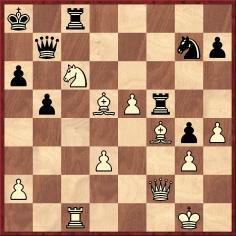
36 Qa7+ Resigns.
Source: New Orleans Times-Picayune, 4 January 1883, page 3.
Wilhelm Steinitz – J. Tardos, Jr.
Simultaneous exhibition, New Orleans, 2
January 1883
Vienna Gambit
1 e4 e5 2 Nc3 Nf6 3 f4 d5 4 d3 dxe4 5 fxe5 Ng4 6 Nxe4 Nc6 7 c3 Qd5 8 Qb3 Qxe5 9 Nf3 Qe6 10 Be2 Qxb3 11 axb3 f5 12 Nf2 Bd6 13 d4 O-O 14 Bc4+ Kh8 15 O-O f4 16 Ne4 Bd7 17 Nxd6 cxd6 18 Ng5 h5 (‘P-R4’) 19 Bxf4 Rf6 20 Bxd6 Rxf1+ 21 Rxf1 Ne3 22 Rf7 Rd8 23 Bf8 Nxc4 24 Bxg7+ Kg8 25 bxc4 Be6 26 Rxb7 Bxc4 27 Bf6 Rb8 28 Rc7 Bd5 29 c4 Resigns.
Source: New Orleans Times-Picayune, 4 January 1883, page 3.
Wilhelm Steinitz – G. Generes
Simultaneous exhibition, New Orleans, 2
January 1883
Two Knights’ Defence
1 e4 e5 2 Nf3 Nc6 3 Bc4 Nf6 4 Ng5 d5 5 exd5 Nxd5 6 Nxf7 Kxf7 7 Qf3+ Ke6 8 Nc3 Nce7 9 d4 c6 10 Bg5 Qd6 11 O-O Qb4 12 Bb3 h6 13 Bxe7 Bxe7 14 Nxd5 cxd5 15 Qxd5+ Kf6 16 Qf7+ Kg5
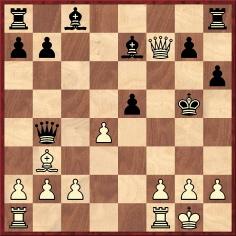
17 h4+ Kg4 18 Qf3+ ‘and mate’.
Source: New Orleans Times-Picayune, 4 January 1883, page 3.
Wilhelm Steinitz – M.J. Fass
Simultaneous exhibition, New Orleans, 2 January 1883
Evans Gambit Declined
1 e4 e5 2 Nf3 Nc6 3 Bc4 Bc5 4 b4 d5 5 exd5 Nxb4 6 Ba3 a5
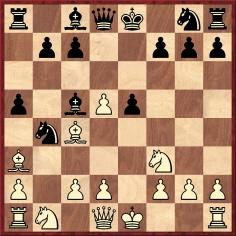
7 c3 Nd3+ 8 Bxd3 Qxd5 9 Qc2 Nf6 10 O-O O-O 11 Ng5 h6 12 Ne4 Nxe4 13 Bxe4 Qd6 14 Bxc5 Qxc5 15 d3 f5 16 Bf3 c6 17 Nd2 a4 18 Rfe1 Bd7 19 Qb2 Rae8 20 Qxb7 Qxc3 21 Nc4 e4 22 Bh5 Re7 23 Qb2 Qxd3 24 Ne5 Qd6 25 Ng6 a3 26 Nxe7+ Qxe7 27 Qc3 Be6 28 Be2 Bd5 29 Bc4 f4 30 Bxd5+ cxd5 31 Qd4 f3 32 Qxd5+ Kh8 33 Qxe4 Qg5 34 g3 Qh5 35 h4 Qf7 36 Re3 Qf6 37 Rae1 Resigns.
Source: New Orleans Times-Picayune, 4 January 1883, page 3.
Wilhelm Steinitz – D.S. Thompson
Philadelphia, 6 November 1883
Falkbeer Counter-Gambit
1 e4 e5 2 f4 d5 3 exd5 e4 4 Nc3 Nf6 5 Qe2 Be7 6 d3 exd3 7 Qxd3 O-O 8 Be3 Na6 9 O-O-O Re8 10 Nf3 Ng4 11 Bg1 Nb4 12 Qd2 c6 13 d6 Qa5 14 dxe7 Be6 15 a3 Nf6 16 f5 Nfd5 17 Nxd5 and wins.
Source: Philadelphia Times, 7 November 1883, page 3.
Julius A. Kaiser – Wilhelm Steinitz
Philadelphia, 27 November 1883
Evans Gambit Accepted
1 e4 e5 2 Nf3 Nc6 3 Bc4 Bc5 4 b4 Bxb4 5 c3 Ba5 6 d4 exd4 7 O-O dxc3 8 Qb3 Qf6 9 e5 Qg6 10 Nxc3 Nge7 11 Ba3 O-O 12 Nd5 d6 13 Bd3 Qh6 14 Bc1 Qe6
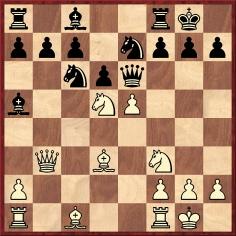
15 Bxh7+ Kh8 16 Be4 Nxd5 17 Ng5 Qxe5 18 Bxd5 Nd4 19 Qd1 Ne2+ 20 Kh1 Bg4 21 f3 Bh5 22 Be4 Nxc1 23 Qxc1 f6 24 Nh3 d5 25 Bd3 Qc3 26 Qd1 g5 27 Rc1 Qd4 28 Qb3 Bf7 29 Bb1 Kg7 30 f4 g4 31 Rfd1 Qb6 32 Qg3 Rg8 33 Qxg4+ Kf8 34 Qh4 Re8 35 f5 Re5 36 Nf4 Ke8 37 Ng6 Re3 38 Qh7 Qd6 39 Qh4 c6 40 Rd4 Kd8 41 Rf4 Rge8 42 Rff1 Bc7 43 Qh7

43...d4 44 Nf4 Qxf4 45 Rxf4 Bxf4 46 Qh4 Bd5 47 Kg1 Bg5 48 Qxd4 Re2 49 Rc3 Re1+ 50 Kf2 R8e2+ 51 Kg3 Rxg2+ 52 Kh3 Rh1 53 Qxd5+ cxd5 54 Kxg2 Rxb1 55 White resigns.
Source: New Orleans Times-Picayune, 6 December 1883, page 8. The game had previously been published in the Philadelphia Record, 28 November 1883.
8591. Seeking reliable information
Any writer on the current campaign for the FIDE presidency (the issues and the personalities) is likely to mention the affair of Ilyumzhinov and aliens, perhaps even placing it dos-à-dos with Kasparov’s statements in support of New Chronology (Fomenko). A far more delicate matter is Ilyumzhinov’s alleged involvement in the murder in 1998 of the journalist Larisa Yudina. The Internet offers a torrent of vehement rumours, speculative accusations and snap verdicts, all worthless. We seek instead articles and documents by respectable writers which deal with the case factually and dispassionately, as well as statements by Ilyumzhinov himself. One example is an interview published by Dylan Loeb McClain in the New York Times, 18 November 2010.
8592. Consultation game (C.N. 8308)
Regarding the consultation game (Budapest, 1921) won by Alekhine, Sämisch, Steiner, Tartakower and Vajda against Abonyi, Bogoljubow, Grünfeld, Kostić and Sterk, we add that one phase was discussed by Tartakower on page 110 of Die Hypermoderne Schachpartie (Vienna, 1924).
8593. The Metropolitan Chess League in 1895
From page 8 of the American Chess Bulletin, January 1932:
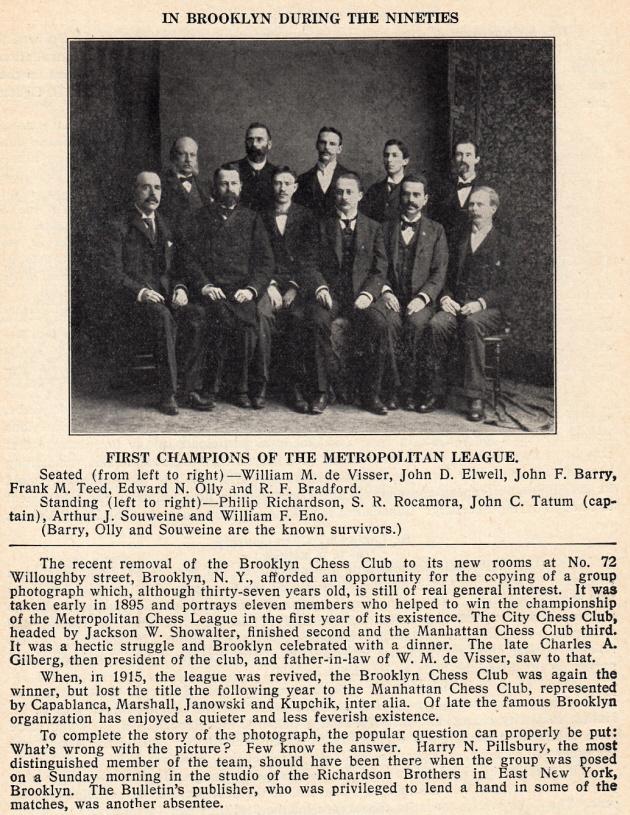
8594. ‘An insidious pitfall’
From pages 151-152 of Chess Traps, Pitfalls, and Swindles by I.A. Horowitz and Fred Reinfeld (New York, 1954):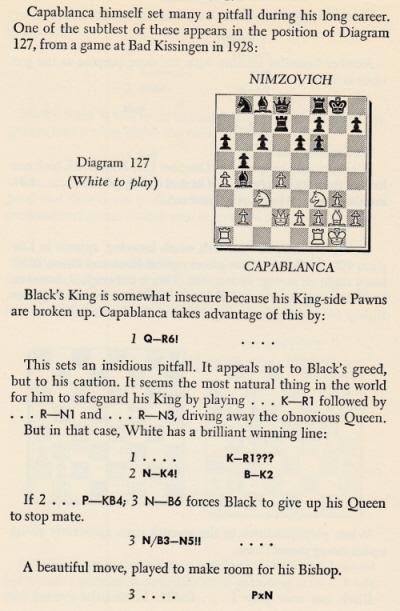
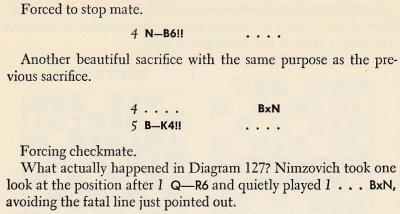
In the initial diagram the white queen should be on c1. We do not know the basis for the co-authors’ statement that after the move Qh6 Nimzowitsch merely ‘took one look at the position’ before ‘quietly’ capturing the knight. Indeed, we cannot say when either player became aware of the mating line; on page 470 of the December 1928 BCM J.H. Blake wrote that it was pointed out by Alekhine.
The world champion annotated the game deeply in the Basler Nachrichten, 8 September 1928:
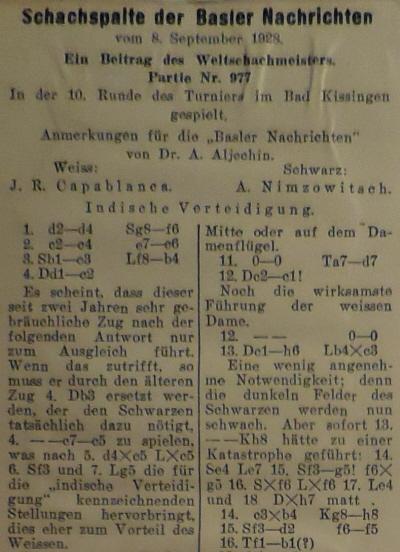
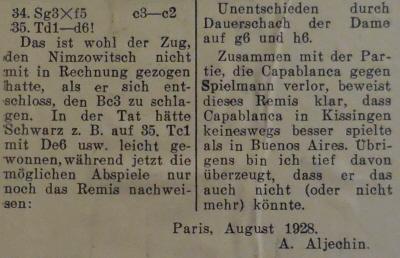
The full notes, incorporating some further remarks, were reproduced on pages 164-167 of the October 1928 Schweizerische Schachzeitung:
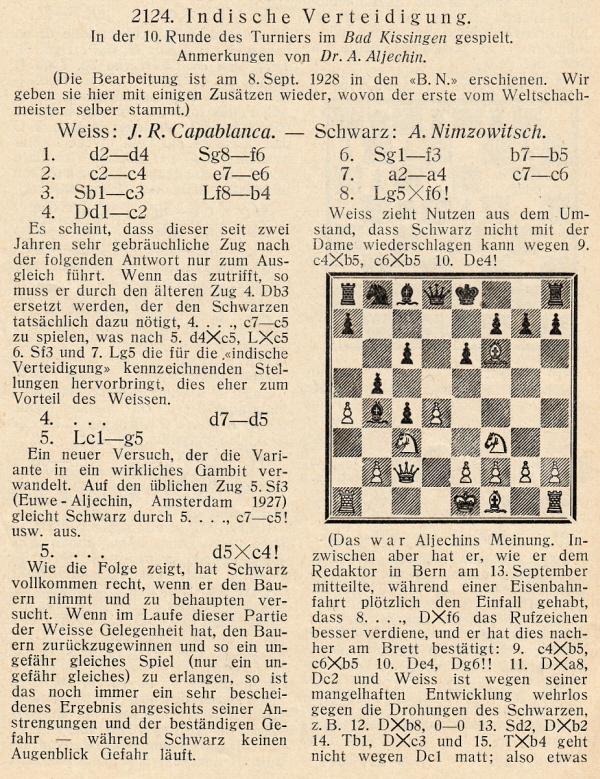

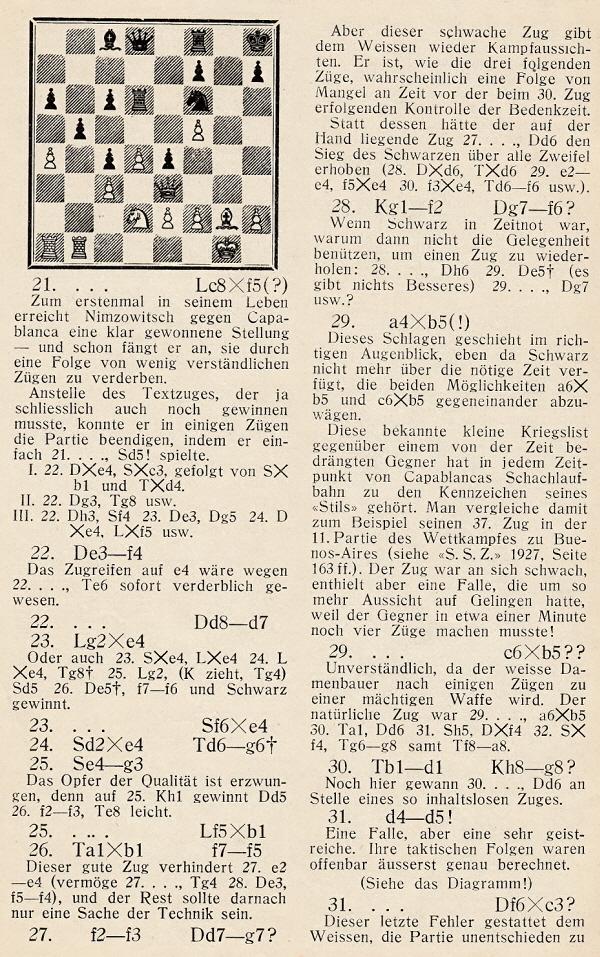
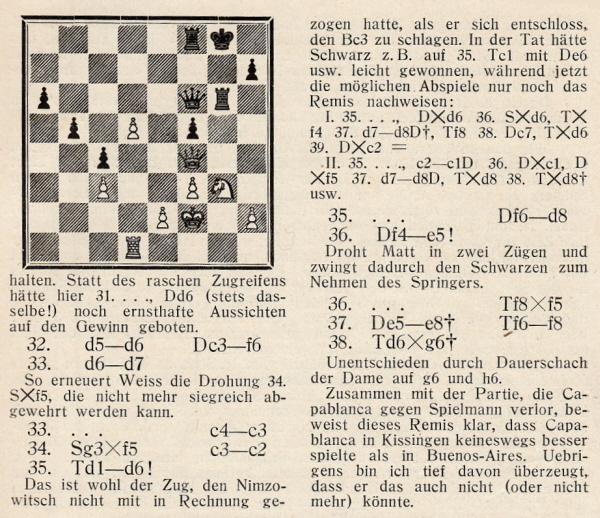
A different German version of Alekhine’s notes appeared, via Tidskrift för Schack, on pages 252-255 of Kagans Neueste Schachnachrichten, August 1929.
From pages 377-378 of the December 1928 Deutsche Schachzeitung:

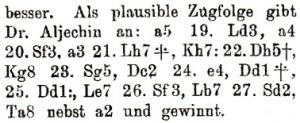
When the Deutsche Schachzeitung had annotated the full game on pages 273-274 of its September 1928 issue, the ‘insidious pitfall’ was overlooked, the following being the note to 13...Bxc3:
‘Es drohte Sc3-e4. Dennoch sollte sich Schwarz lieber die beiden Läufer erhalten, z. B. 13...Kh8! 14 Se4 Le7 als Tg8 und Tg6.’
Similarly, the notes in The Field, reproduced on pages 83-84 of the January 1929 Chess Amateur, stated after 13...Bxc3:
On pages 27-29 of Schachjahrbuch 1928 by L. Bachmann (Ansbach, 1929) the moves 12...O-O 13 Qh6 Bxc3 14 bxc3 Kh8 were given without comment. Nor was the mating trap mentioned in C.S. Howell’s annotations on pages 137-138 of the September-October 1928 American Chess Bulletin.‘To stop Kt-K4. Better, however, would have been 13...K-R1 14 Kt-K4 B-K2, followed by ...R-Kt1 and ...R-Kt3.’
A detailed set of annotations appeared in Tartakower’s German-language tournament book. See too the coverage of the game on pages 37-41 of Aaron Nimzowitsch 1928-1935 by Rudolf Reinhardt (Berlin, 2010), or pages 39-43 of the English edition (Alkmaar, 2013).
8595. The tree of chess knowledge
From an article about Tartakower by Genna Sosonko on page 42 of the 6/2010 New in Chess:
‘Chessplayers are familiar with the so-called pearls of eastern wisdom that were dreamt up by Tartakower. One of the most well known of them goes: “There are players who are weak and don’t know that they are weak: these are ignoramuses – avoid them! There are players who are weak and know that they are weak: these are smart – help them! There are players who are strong and don’t know that they are strong: these are modest – respect them! There are players who are strong and know that they are strong: these are chess sages – follow them!”’
C.N.s 56, 263, 485 and 1200 discussed this quotation, including the unresolved question of whether it originated with Sir Richard Burton in the late nineteenth century.
As regards Tartakower, this paragraph was published on page 22 of his booklet Am Baum der Schacherkenntnis (Berlin, 1921):
‘Arabische Weisheit. Es gibt Spieler, die schwach spielen und nicht wissen, daß sie schwach spielen: das sind Ignoranten – meide sie! Es gibt Spieler, die schwach spielen und wissen, daß sie schwach spielen: das sind Einsichtige – hilf ihnen! Es gibt Spieler, die stark spielen und nicht wissen, daß sie stark spielen: das sind Bescheidene – achte sie! Es gibt Spieler, die stark spielen und wissen, daß sie stark spielen. Das sind die Schachweisen – folge ihnen!’
The same quotation (introduced not by ‘Arabische Weisheit:’ but by ‘Ein morgenländischer Spruch lautet’) appeared on page 43 of Tartakower’s Die Hypermoderne Schach (Vienna, 1924), followed by a brief additional paragraph:
‘Capablanca weiß, und er weiß, daß er weiß. – Wollen wir ihm folgen? ...’ [‘Capablanca knows, and he knows that he knows. – Do we wish to follow him? ...’]
Harry Golombek gave the saying in two chess columns in the Review section of The Times (24 May 1969, page 21, and 30 September 1972, page 10), and in the latter he added:
‘Fischer belongs to this last category, and the number of his followers among masters and amateurs alike is inevitably enormous. Few if any of these doubt that he is the strongest player the world has ever seen and, even if they cannot achieve his results, at least they will imitate his methods of play. ... I entertain the fervent hope that Fischer’s healthily direct approach to the game will be imitated by exactly those players who employed the negative methods of Petrosian when he was world champion. In chess, as in most of life’s pursuits, fashion and success go hand in hand.’
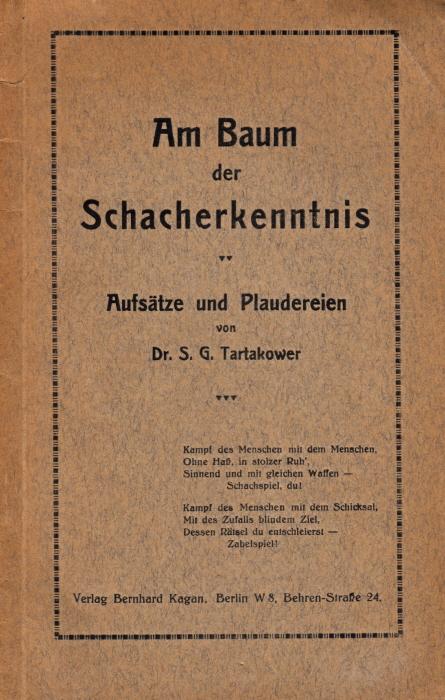
8596. Confusion
From Eduardo Bauzá Mercére (New York, NY, USA) comes an addition to Confusion (a game between Fedden and Wayte published in the BCM, June 1884, pages 256-257):
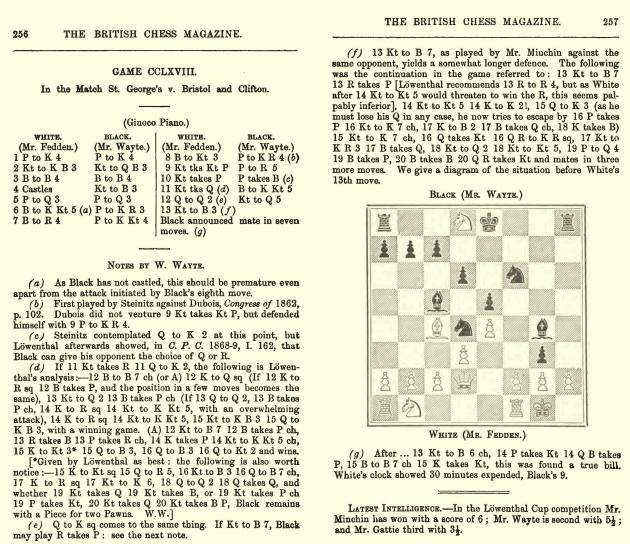
8597. Chess
Skirmishes (C.N. 8573)
Pages of 57-58 of Chess Skirmishes by I.O. Howard Taylor (Norwich, 1889) are shown below, courtesy of the Cleveland Public Library:
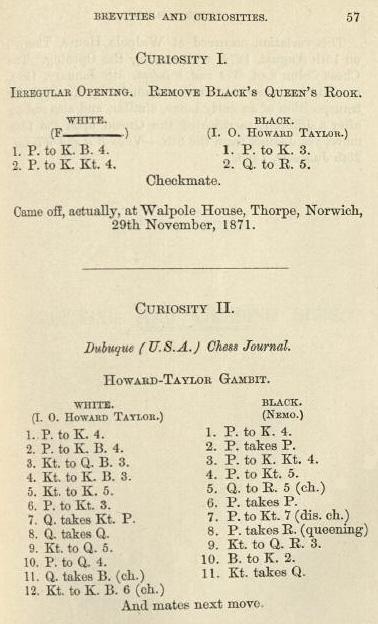

8598. A 1941 photograph
Paweł Dudziński (Ostrów Wielkopolski, Poland) asks for information about a photograph dated 1941 which he acquired recently:
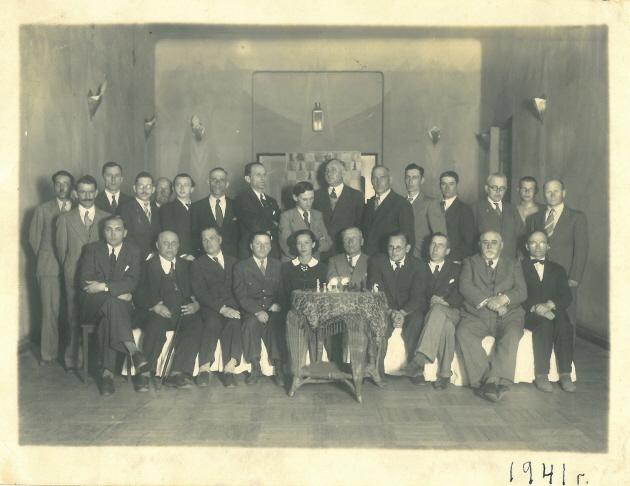
8599. The 1937 New York City mayoral election
From page 74 of The Chess Player’s Bedside Book by Raymond Bott and Stanley Morrison (London, 1966):
‘Politics and Vote Catching
In the New York mayoral election for 1937, the following circular was distributed:
“Vote for Judge Mahoney – because he is a chess player ... I am certain that when he is Mayor he will honour great masters arriving in this country with proper civic recognition and will promote and foster chess as an educational and cultural activity in New York.”
Result: La Guardia won the election. Perhaps his opponents should have put up a baseball advocate.’
Wanted: further information about any chess connection with the 1937 mayoral campaign run by Jeremiah Titus Mahoney (1878-1970).
8600. The Duke of Brunswick at the Opera
Hans Renette (Bierbeek, Belgium) provides a cutting from page 4 of the Innsbrucker Nachrichten, 26 November 1857 (i.e. about a year before the Morphy v the Duke and Count game):

‘Paris, 13 Nov. Yesterday, Duke Charles of Brunswick caused a great scandal at the Théâtre des Italiens. He was playing chess with his companions during the performance and making so much noise that the theatre’s director had to demand that he be quiet.’
8601. Mysterious understatement
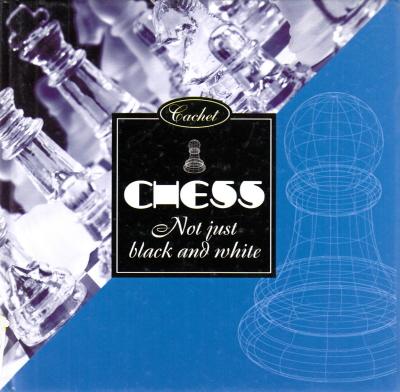
From a set of four ‘Fascinating facts’ on page 37 of a US book, Chess. Not just black and white (Valencia, 2003):
‘The country with the greatest number of chess grand masters is Russia, with eleven players of international standard.’
8602. Chess and baseball (C.N.s 3044
& 3055)
Robert John McCrary (Columbia, SC, USA) writes:
‘The book Baseball in the Garden of Eden (New York, 2011) by the reputable baseball historian John Thorn mentions two major early baseball pioneers who were also important in nineteenth-century chess. One is William R. Wheaton, who was a founding member of the Knickerbocker Baseball Club in 1845, and served as the Club’s first Vice President (see page 37 of Thorn’s book). The Knickerbocker Club has long been credited as a major force in standardizing baseball rules, and thereby starting the game on its path toward becoming the organized “national game” of the United States. Thorn argues that Wheaton played a major role in writing those original Knickerbocker rules, which have been reprinted numerous times in baseball histories. Wheaton is one of six Knickerbocker Club members pictured in a famous daguerreotype dated 1845. On page 36 Thorn calls him “the most important Knickerbocker” in the early weeks of the Club’s existence.
On page 134 Thorn writes:
“The New York game as the national pastime? Chess was more widespread and better organized. The First American Chess Congress of 1857 had included four members from California on its ‘Committee of Cooperation’, including the ever-inventive William R. Wheaton, now of San Francisco.”
This is confirmed on page 57 of the New York, 1857 tournament book.
The other early major baseball pioneer who was also a significant chess figure was Henry Chadwick of Brooklyn. Active in the early decades of organized baseball, Chadwick is considered the “father of baseball”, the originator of many traditional baseball statistics, and a major influence on baseball writing, literature and the evolution of rules and organization. Chadwick was also a chess columnist, writer, and official of some influence. Page 108 of the July 1897 American Chess Magazine reported:
“Henry Chadwick, of baseball and chess fame, gave a simultaneous performance ... winning eight out of 12 games played.”’
A feature article entitled Chess and Baseball is in preparation.
8603. Attributed to Spielmann (C.N. 8579)
From page 3 of Meet the Masters by Max Euwe (London, 1940):
‘Ordinary mortals can envy Alekhine’s genius in the discovery of charming and startling combinations; the more skilful player who feels himself quite capable of executing such combinations has a different feeling on the subject. To quote Spielmann, who is surely competent to pass an opinion on combinative skill: “I can comprehend Alekhine’s combinations well enough; but where he gets his attacking chances from and how he infuses such life into the very opening – that is beyond me. Give me the positions he obtains, and I should seldom falter. Yet I continually get drawn games, even out of the King’s Gambit.”
Well said, Master Spielmann! Alekhine’s real genius is in the preparation and construction of a position, long before combinations or mating attacks come into consideration at all.’
In case it helps in tracing the original of Spielmann’s words, below is the relevant section of pages 2 and 3 of the Dutch edition of Euwe’s book, Zóó schaken zij! (Amsterdam, 1938):

8604. New feature articles
Two feature articles have just been posted: A Chess Gamelet and Chess and Baseball.
8605. First place after a poor start
From Dan Scoones (Port Coquitlam, BC, Canada):
‘At Palma de Mallorca, 1969 Bent Larsen began with two losses but came back to take clear first place. So did Alexander Beliavsky at Tilburg, 1986. How often has this happened in important international tournaments, and has anybody ever won such an event outright after a 0-3 start?’
8606. Quotability
Among the ploys available to a chess writer eager to be quoted is recourse to inapposite, exaggerated comparisons, similes and metaphors which offer the apparent thrill of mentioning names not normally seen in chess literature. The stratagem is not new, and even a fine author may succumb to the temptation. From page 25 of Fischer v. Spassky Reykjavik 1972 by C.H.O’D. Alexander (Harmondsworth, 1972):
‘However, while the conditions of the match are simple, the two-month match itself is a gladiatorial contest compared with which Joe Frazier v Muhammed Ali is just a friendly little chat.’
The line has indeed been cited elsewhere, and notably by Alexander himself on page 44 of A Book of Chess (London, 1973).
Other short-cuts to being quoted include bogus epigrams, extravagant historical comparisons, and hyperbolic praise or criticism of a given master’s play. For some reason, a foray into zoology can be particularly useful. The writer managing to work, say, ‘cobra’ into any description of a player or game may well find the phrase picked up by others.
8607. Stalemate and deadlock (C.N. 7116)
A small feature in the Chess Amateur, September 1928, page 369:
‘The Inevitable Blunder: – How many authors and journalists go wrong over the term “stalemate”? Legions of them. Here is the usual mistake:
“I watched him silently, unable to decide whether to continue the futile argument or not. There was stalemate between us. He had as strong a hold on me as I had on him.” (J. Chancellor in The Mystery of Norman’s Court, Chapter vii).’
The fact is, of course, that in the ordinary language the word has not really changed its meaning.’
The online Oxford English Dictionary cites two figurative uses of ‘stalemate’:
- The Times, 15 December 1885: ‘The Prince ... will not ... consent to the stalemate of mutual evacuation proposed by Servia.’
- Standard, 20 September 1912: ‘So far as the public can see the match [between the two armies] ended in stalemate.’
Below is the entry on page 1593 of the Collins Dictionary (Glasgow, 2011):
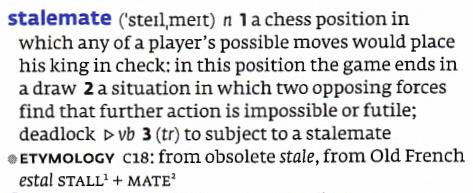
8608. Checking
C.N.s 6416 and 6432 examined the saying ‘Never miss a check, it might be mate’. A less familiar remark was made by Irving Chernev when discussing a Reshevsky v Bronstein position on pages 73-74 of Combinations The Heart of Chess (New York, 1960):
‘Once you start checking it’s hard to stop.’
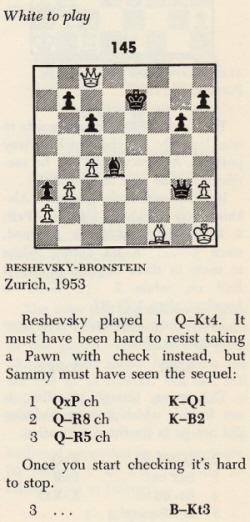
8609. Chess and baseball
Avital Pilpel (Haifa, Israel) writes:
‘As quoted on pages 232-233 of Chess Explorations, Alistair Cooke drew parallels between chess and American football. Baseball too is a game played in turns (pitch by pitch, batter by batter). As in the case of American football, players from both teams often seem to run to positions on the field that bear no relation to the batter or pitcher; it is all part of various well-known strategic plans for either the offensive team (such as “sacrifice fly” and “stealing a base”) or the defensive team (e.g. “intentional walk” and “double play”) which the baseball fan recognizes instantly.
However, baseball, unlike American football, has many strategies which involve the equivalent of a chess sacrifice. Generally, of course, the batter tries to “get on base” by hitting the ball, while the defending team tries to prevent him from doing so. Nonetheless, a batter may “sacrifice” himself, as it is called – intentionally hit the ball in a way that will get him “out” of the game, not reaching the bases – so as to improve the position of another player on his team. Or a pitcher may intentionally allow a batter to advance to a base, judging that the result (for various reasons) would actually lower the batting team’s chances of scoring points.’
8610. The Emir Abdullah
From page 469 of the December 1922 BCM:
‘A picturesque scene took place at the Imperial Chess Club, 17 Stratford Place, on 31 October, when His Highness the Emir Abdullah of Transjordania visited the Club with his suite, all in gorgeous oriental costume. He was accompanied by his interpreter, Mr Philby, a notable Arabic scholar and lecturer of the Royal Geographical Society, also by his native physician. Señor Capablanca was invited (being his last evening in London) to meet the Emir, and played with him. This was the only game His Highness lost. He expressed great pleasure at his reception by the Club.’
The final paragraph of an item about the Imperial Chess Club on page 326 of the August 1923 Chess Amateur:
‘During the chess season His Highness the Emir Abdullah of Trans-Jordania paid two visits to the Club. He came in full oriental costume, attended by his suite. He played chiefly the Fianchetto opening and won all his games until the arrival of Señor Capablanca, and then, like the rest of the members of the Club, he was obliged to resign to the Chess Master of the World.’
8611. Comparisons between Morphy and Rosenthal
Drawing attention to a bizarre report on page 96 of Le Monde Illustré, 5 February 1876, Jerry Spinrad (Nashville, TN, USA) comments:
‘Even though the report exaggerates the size of Morphy’s blindfold exhibition, stating that it was on 12 boards, it more or less dismisses as unimportant the fact that it was given blindfold. The writer suggests that Morphy, a lazy Creole, seemingly dozed in the comfort of an armchair and merely murmured his moves. Rosenthal’s over-the-board simultaneous display, in which he had to walk constantly, is regarded as far more impressive.’
Three games from Rosenthal’s 29-board exhibition (Paris, 28 January 1876) are given in A Forgotten Showman.
8612. Book dedications
An addition to this topic (earlier items are listed in the Factfinder) comes from pages i and ii of Chess Skirmishes by I.O. Howard Taylor (Norwich, 1889). The text by Taylor (who is described on the title page as ‘Officer of his Hawaiian Majesty’s Order, the Star of Oceania’ ) begins ...
‘To His Majesty, King Kalakaua.
May it Please Your Majesty,
Sire,’
... and attains this oily crescendo:
‘In taking, during the Jubilee year of the British Sovereign, that far journey from home, Her Majesty Queen Kapiolani was like yourself, Sire, who remained at Honolulu, true to the fundamental conceptions of chess, and the lessons it conveys.
In dedicating this humble work, by gracious permission, to your Majesties, I have the comforting assurance that in the beautiful islands over which your rule extends, where deepest attachment reigns between highest and lowest, every shortcoming will be forgiven for the sake of my homage to a King and Queen, so much and so justly loved.
I have the honor to be, Sire,
With profoundest respect,
Your Majesty’s faithful Officer and Servant,
I.O. Howard Taylor.’
8613. Capablanca v Bogoljubow, Moscow, 1925
Analytical Disaccord provides an English translation of Capablanca’s annotations published on pages 34-35 of Kagans Neueste Schachnachrichten, January 1926. We have now obtained a copy of the Cuban’s original manuscript:
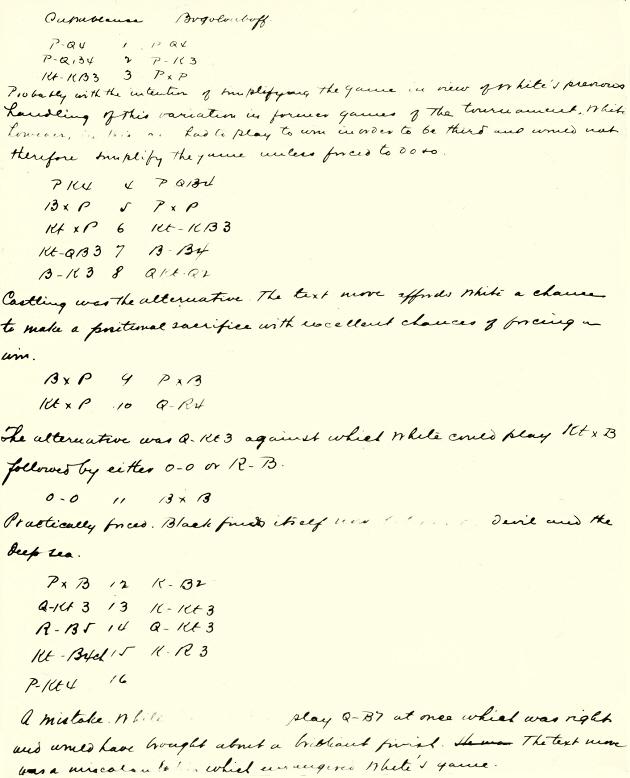
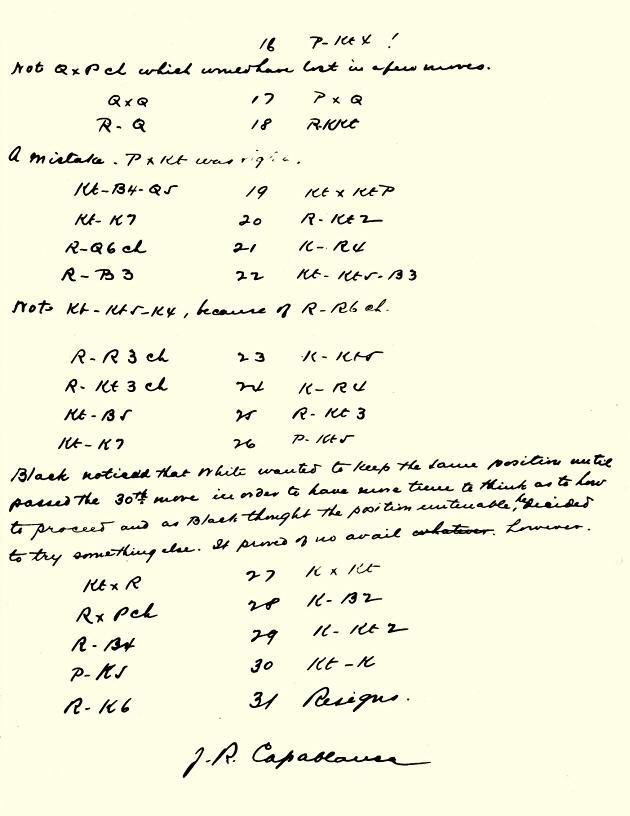
8614. Capablanca photograph
Another recent acquisition is a photograph taken, we estimate, circa 1912:
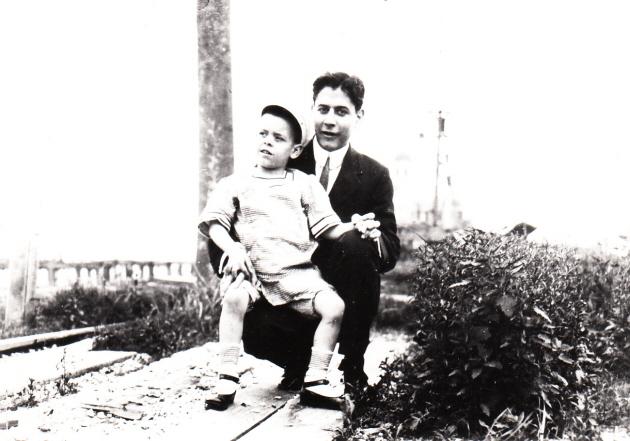
8615. Zugzwang
Old attempts to explain Zugzwang are always welcome. The following reply to a correspondent comes from page 154 of the September 1902 Schweizerische Schachzeitung:
‘E.H., Lausanne. La signification de Zugzwang est littéralement “contrainte de jouer”. Cela veut dire que les Noirs répondant au 1er coup des Blancs, sont obligés de se mettre sous un mat dont ils ne seraient même menacés s’ils pouvaient déranger aucune pièce.’
8616. Zukertort’s burial
From John Townsend (Wokingham, England):
‘There are two documents at the National Archives regarding Zukertort’s burial in Brompton Cemetery.
In the burial register (WORK 97/165), entry no. 141702 relates to the burial of Johann Hermann Zukertort on 26 June 1888, performed by Rev. A. Veysey. Charing Cross Hospital is stated as the place of his death, and his age is given as 46 years. It was a “Common Grave” at the depth of five feet, the deceased having been removed from the parish of St Martin in the Fields, Westminster.
The records of Brompton Cemetery also contain “Burial Books”, which include copies of the bills issued. In Burial Book No. 471 (WORK 97/679), entry no. 139748 cross-refers to the above entry no. 141702 in the burial register. The time was one o’clock on Tuesday, 26 June 1888. The name of the deceased, age, and place of death are the same. The undertaker was G.T. Poole, St. Martin’s Lane. The charge was £1 16s. for “Common Interment in Grave”. On the facing page has been added:This appears to mean that the expense was met by the parish of St Martin in the Fields (into which Charing Cross Hospital fell).’“The Parish of St Martin in the Fields
G.T. Poole.”
8617. Blindfold win by Kostić
Wanted: information about the simultaneous blindfold game below, published on page 226 of the May 1920 Chess Amateur courtesy of the Morning Post:
Boris Kostić – N.N.
Hastings (date?)
Queen’s Gambit Declined
1 d4 d5 2 c4 e6 3 Nc3 Nf6 4 Bg5 Be7 5 e3 a6 6 Nf3 Nc6 7 Rc1 O-O 8 Bd3 Nh5 9 h4 f6
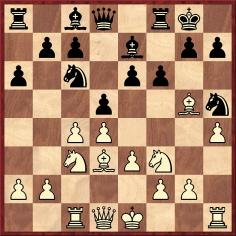
10 Ne5 fxe5 11 Qxh5 e4 12 Nxe4 dxe4 13 Bxe4 g6 14 Bxg6 hxg6 15 Qxg6+ Kh8 16 Rh3 Bf6 17 Rg3 Bxg5 18 hxg5 e5 19 Ke2 Resigns.
The Chess Amateur made no comment on 19 Ke2 or on Black’s decision to resign.
8618. Mieses in Basle
From page 55 of the April 1907 Schweizerische Schachzeitung comes a game played in a 21-board simultaneous display:
Jacques Mieses – N.N.
Basle, 27 February 1907
Vienna Game
1 e4 e5 2 Nc3 Nc6 3 Bc4 Bc5 4 Qg4 Qf6 5 Nd5 Qxf2+ 6 Kd1 Kf8 7 Nh3 Qd4 8 d3 d6 9 Qh4 Bxh3 10 Qxh3 Qf2 11 Be3 Bxe3 12 Nxe3 Nd4 13 Rf1 Qe2+ 14 Kc1 Nf6 15 a4 Nxc2
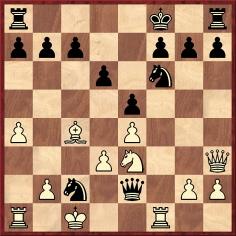
16 Rxf6 Qxe3+ 17 Qxe3 Nxe3 18 Rxf7+ Ke8 19 Rxc7 Nxc4 20 dxc4 Rf8 21 Ra3 Rf7 22 Rxf7 Kxf7 23 a5 Rc8 24 Rc3 Ke6 25 b4 a6 26 Kd2 g6 27 Kd3 Kd7 28 c5 dxc5 29 Rxc5 Rxc5 30 bxc5 Ke6 31 g3 g5 32 g4 h6 33 Kc4 and wins.
8619. Mieses v Voellmy
Another game from the simultaneous exhibition mentioned in C.N. 8618 was published on page 58 of the Schweizerische Schachzeitung, April 1907 with the winner’s notes:
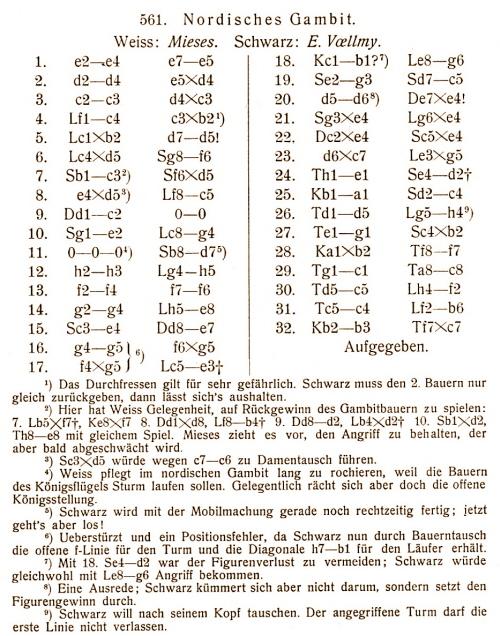
Jacques Mieses – Erwin Voellmy
Basle, 27 February 1907
Danish Gambit
1 e4 e5 2 d4 exd4 3 c3 dxc3 4 Bc4 cxb2 5 Bxb2 d5 6 Bxd5 Nf6 7 Nc3 Nxd5 8 exd5 Bc5 9 Qc2 O-O 10 Nge2 Bg4 11 O-O-O Nd7 12 h3 Bh5 13 f4 f6 14 g4 Be8 15 Ne4 Qe7 16 g5 fxg5 17 fxg5 Be3+ 18 Kb1 Bg6 19 N2g3 Nc5 20 d6

20...Qxe4 21 Nxe4 Bxe4 22 Qxe4 Nxe4 23 dxc7 Bxg5 24 Rhe1 Nd2+ 25 Ka1 Nc4 26 Rd5 Bh4 27 Rg1 Nxb2 28 Kxb2 Rf7 29 Rc1 Rc8 30 Rdc5 Bf2 31 R5c4 Bb6 32 Kb3 Rfxc7 33 White resigns.
This is one of the earliest over-the-board occurrences of 5...d5; see the comments in Chess: The Greatest and on pages 157-158 of Kings, Commoners and Knaves. Our text was reproduced with many errors on pages 81-82 of Danish Dynamite by Karsten Müller and Martin Voigt (Milford, 2003).
We should welcome substantiation of a reference to the move on page 76 of Danish Gambit by W. John Lutes (Coraopolis, 1992):
‘This ingenious return of the gambit pawn is believed to have been discovered by Danish analysts as early as the 1870s in the Nordisk Skaktidende.’
8620. Cook problem
In his obituary of Eugene Beauharnais Cook on pages 65-67 of the April 1915 American Chess Bulletin Alain C. White wrote:
‘... he never entirely gave up composition, and only a few months ago he sent me the following jeu d’esprit, which he called “The Hermit”. It was probably his last composition. “In it”, he said, “the king and peasant quietly enjoy their hermitage, while two complete armies of the Black heathen may rage without.”’

White to move and draw.
| First column | << previous | Archives [116] | next >> | Current column |
Copyright: Edward Winter. All rights reserved.
